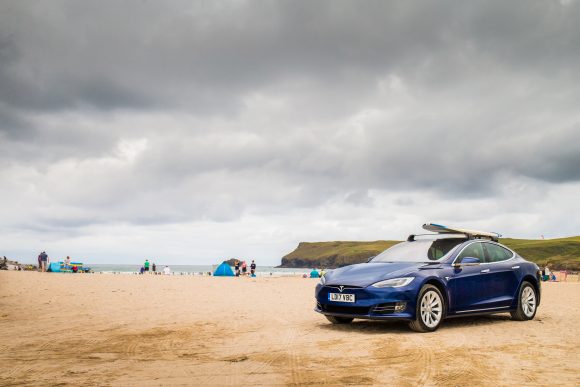We know that electric vehicles can make sense around town, with plenty of available charging and only short daily drives, but what if your life is more rural? Rebecca Chaplin put the latest Tesla Model S P100D to the test on a Great British holiday.
NOTHING but the sound of the wind rushing around the car can be heard. That plus the surfboard that’s occasionally knocking on the roof bars and a two-year-old chattering in the back. The joys of a family holiday…
This time the ‘spaceship’ noise, as our younger passenger keeps calling it, is because we’re taking on the 200-mile trip from Southampton to Tregonetha in Cornwall in a Tesla Model S.
Attempting a journey like this would have been nearly impossible in an electric car before the latest generation of models became available – those such as the Renault Zoe and Nissan Leaf, which now have more than 200 miles of range – but the Tesla has been there for a while. Now with around 315 miles of range if you’re behind the wheel of a 100D such as this, the idea of range anxiety seems almost ridiculous.
Diehard readers of Car Dealer Magazine will remember that two years ago I drove a Tesla Model S to Norway using only the Supercharger network. The strange thing is, back then you couldn’t have done the trip that I’ve just completed to Cornwall.
That was a very different time for electric cars in the UK. Ecotricity points at service stations were free (although many of them still don’t work, so it’s neither here nor there that you need to pay) and the uptake of people using them was far lower, but if you did buy one you got a fairly reasonable sum from the government.
You’d almost question why anyone would want to buy an electric car these days, as the perks have certainly fallen off a cliff.
With it being so long since I last stepped into a Tesla, but the general look and feel of the car remaining almost the same, I wasn’t expecting to be blown away by the ‘pros’ versus ‘cons’.
I had to go to Tesla’s West Drayton store to collect the car, and after a short interview with Channel 5 on the topic (#humblebrag) that never aired (#notsuchahumblebragnow) I was in our car with 80 miles back to the office.
The M25 wasn’t moving – a huge surprise on a Friday afternoon – so I decided to go the long way via the M4. Then, of course, the M3 was also at a standstill, so I went the even longer way to get around it. With a fully charged battery this trip took close to three hours but the Tesla was unfazed, even with music blaring from its speakers and the air conditioning on.
There’s no Supercharger in Gosport or near it. Even with the cities of Southampton and Portsmouth nearby, the closest point is on the A34, and the only others on the south coast are Exeter and near Dover. Of course, Superchargers aren’t for daily use, and any electric car owner with half a brain will have a home charging point. It did become clear, though, that this is only an option for people who can park their cars on a driveway or in a garage.
If I wanted to charge a Tesla at my terraced house, I’d have to trail the cable out of my front window and across the pavement.
My friends who were accompanying us would have the same problem, and anyone living in a flat would have no chance.
This sounds like I’m really not keen on electric cars, but that would be extremely wide of the mark. I love electric cars. However, when it comes to infrastructure, there are some serious issues that still need addressing if they’re going to become an option for a large proportion of our nation by 2040.
That was what drew me to our stay for the trip – the Old Barn, Tregonetha. A promoted post on Twitter from the holiday home boasted that it was the first self-catering cottage in the UK to have a Tesla charging point. Whether it is or not is up for debate, but it’s at least an early adopter.
Out in the far reaches of Cornwall, owner Stephen Chidgey had installed the ‘destination charging point’ after a customer who had a Model S had to charge it with an extension lead through the window.
With our destination set, the Tesla was telling me that I didn’t have enough charge to get there. One of the nifty features is that when you plan your route you’ll be told how much charge will remain when you arrive and whether you can do a round trip. It also plans in charging stops so you can make it, and you find yourself using the sat nav even when you know where you’re going.
Fortunately for this trip we’d be able to take advantage of the Supercharger station in Exeter.
There were five of us on board: my partner and I, our two friends and their two-year-old. We were only going away for two nights but the car was packed to the brim.
The next plus point for the Model S is the excess of storage space. The 100D is all-wheel drive, so there are twin electric motors but still no engine or transmission to worry about.
However, having four and a half people on board and every bit of storage space filled does affect performance. The accurate range from my journey the day before wasn’t what I was experiencing now. When I’d parked at home I’d checked how our journey would pan out and when we left it agreed, but a few miles down the road the picture wasn’t looking so rosy.
Closing in on Exeter service station, I was definitely not the most agreeable person with just 30 miles of range remaining. An even more worrying factor was that we weren’t going to Exeter services. The directions were taking me somewhere else and I began to panic that there would be no Tesla Superchargers at all. We arrived at a farm shop called Dart Farm, and after some slight confusion and hopefully disguised panic as I drove around the car park, the three spaces for Teslas appeared – one already taken with a Model X.
We plugged in, and although I’d been shown the key commands to open the various compartments, all I could manage was to pop the bonnet every time, so used the screen each time to reveal the port.
The Model S had told me I only needed to charge for 20 minutes to make it to my destination, but with the charging time having raced to 300 miles of range for every hour plugged in, an hour’s stop doesn’t seem that long at all – particularly once you’ve grabbed a coffee and stretched your legs. Back in the car and now fully charged, there was no need to worry about running out of battery for the last 80 miles of our journey. However, even the Tesla isn’t smart enough to avoid traffic (something you’d think would be vital in an electric car) and we soon got trapped in some roadworks traffic.
When you first begin driving the Model S the regenerative braking feels a bit unnatural. Every time you pull back on the accelerator the car brakes for you, so you soon find yourself using only one pedal most of the time and touching the brake only when you really need to.
In traffic like this, though, it’s a dream. You’ll soon gain back a couple of miles of charge too in stop-start traffic.
After what seemed like forever on the road we arrived in Tregonetha, which is located between Bodmin and Newquay, where there is little more than a collection of a few houses that make up the village.
One of our first questions when we were greeted by owner Chidgey was about the nearest shop, and he replied: ‘Well, there’s a Co-op about four miles that way or another shop about four miles the other way.’
If you’re looking for peace and tranquillity, it doesn’t get much better than this, with views of the sea from the bottom of the garden and not a peep to be heard from the road. The Old Barn is a fitting location for the Tesla, not only because of its charging points but also because it’s an ‘eco cottage’.
It’s been carefully designed to use as little energy as possible without losing any of the character. Solar panels for electricity and storing hot water are on the roof, the whole house is kept warm with underfloor heating and LED lights are used throughout. The biggest draw on power in this house will be when you charge your electric car overnight.
As I’m sure you know, once you’re in Cornwall everything is very nearby, so worrying about running out of battery shouldn’t really be a concern – in fact, we see a few other Teslas on holiday in the area. That said, after yesterday’s low battery, I’ve become a little bit more anxious about getting stuck. Luckily, there are helpful phone apps such as Zap Map, where you can find charging points. Once you open this you’ll see you’ll be well served, with places to charge all the way to Land’s End, if you wanted to travel that far.
Today we’ll just be driving around the bay – on the lookout for some surf – but also to get some photos of the Tesla in this location. We stop at Polzeath, where you’re allowed to park on the beach, before heading for some higher points along the coast.
Photographer Jon Reay is enjoying the stark contrast of a Land Rover Discovery with a diesel engine. While we’re driving, he calls to ask if we can stop for fuel.
It turns out petrol stations are just as hard to find in Cornwall as charging points. The devil in me was almost hoping that we wouldn’t find one, as if he did run out of fuel it would make a fantastic angle for my story, but fortunately – or should that be unfortunately? – with a few miles left in the tank we did.
On our return journey we stop again at Exeter, purely for my own peace of mind, but the Tesla could have easily got us home. The fact of the matter was it was me who needed the break, not the car.
Filled with confidence about the capabilities of the 100D, I decided to take it to London the next day for a meeting. It would mean leaving early in the morning to beat the traffic, but at least I wouldn’t have to sit on a train, and I would only have to pay for parking. With under 100 miles of range now, the onboard computer predicted that I would have just six per cent battery left when I arrived. I’d found a car park with charging points, though, so I wasn’t worried.
I’d learnt my lesson and I didn’t need to panic. Six per cent was 14 miles and more than enough wiggle room.
I got on the road, but by the time I was on the A3 it had begun to warn me that I needed to drive at under 60 miles an hour to get there. Don’t be stupid, I thought, and it replied with ‘please drive under 55mph’. I complied, and with cruise control on it wasn’t really an issue, as we were soon in the usual slow drive into London.
My own stupidity meant that I’d arrived in a car park where I’d assumed they’d offer the perk of free charging. No such luck, and I needed a Chargemaster card to pay for it, which I didn’t have. I wasn’t too worried, though, as I knew that I could get to Westfield where there’s a Tesla Store, charging points and – best of all – coffee.
My meetings were over by about 2pm and I got on the road. Leaving the car park, though, 14 miles of range suddenly became nine. Why, I’ve no idea, and the air con and radio were suddenly and rapidly automatically disabled.
Nine miles of range to go two miles down the road is no reason to panic, I told myself, but when things start switching off it does make you a little nervous – especially as I was now trapped in slow-moving London traffic going past Hyde Park and the last thing I wanted was to be the Tesla rescued from the side of the road. I was willing that huge screen to switch off and stop wasting power… As you can probably imagine, it took around half an hour to drive those two miles but it made it. I’m sure if things had got really dire, though, the Model S would have asked me to park up somewhere safe.
Once in Westfield I sat down to do some work in the car for 45 minutes and was on my way again. The thing is, the car was more than capable of completing these journeys. However, working within the parameters of infrastructure is what held things up.
There are 23 years until 2040 and it’s just taken four years to complete a smart motorway on the M3. Can we even come up with a workable alternative solution in that time?
Well, probably, but it’s certainly going to cost a lot.
THE KNOWLEDGE
Model: Tesla Model S 100D
Price: £90,000
Engine: Electric motors
Power: 371bhp
Max speed (limited): 155mph
0-60mph: 4.2 seconds
Range: 393 miles
Emissions (g/km): 0








































